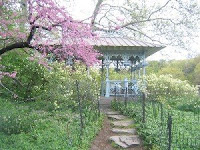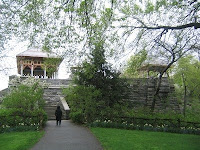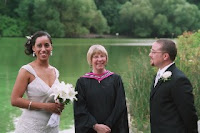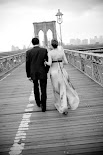
 The Obelisk is behind the Metropolitan Museum. In the spring, it is approached through an avenue of cherry trees and is stunning. Ample parking in the Museum parking lot, so good for elderly guests. A short ways away is a nice lawn with a stone bench, also suitable for a standing wedding, and if you continue further up the path, you can reach the dancing terrace below the Belvedere castle, which slopes down to the pool, and has a view of the castle.
The Obelisk is behind the Metropolitan Museum. In the spring, it is approached through an avenue of cherry trees and is stunning. Ample parking in the Museum parking lot, so good for elderly guests. A short ways away is a nice lawn with a stone bench, also suitable for a standing wedding, and if you continue further up the path, you can reach the dancing terrace below the Belvedere castle, which slopes down to the pool, and has a view of the castle.

There are the two little covered pergolas on the Belvedere Terrace, one overlooking the Delacorte Theatre (the castle is hidden between them). Remember that this is a tourist location, and it will be constantly busy on a warm weekend.

 Here is the Shakespeare Garden, which has a nice sundial in the middle. PLEASE NOTE that this location is only suitable for 6-10 people - the garden itself is quite small, and the ground slopes around the sundial and the tree is low. For a larger group (15-20) go up the hill to the Belvedere terrace in front of the castle - see the pergolas above.
Here is the Shakespeare Garden, which has a nice sundial in the middle. PLEASE NOTE that this location is only suitable for 6-10 people - the garden itself is quite small, and the ground slopes around the sundial and the tree is low. For a larger group (15-20) go up the hill to the Belvedere terrace in front of the castle - see the pergolas above.
Other overlooked spots are: The Harlem Meer, The Loch, Cop Cot by 59th street (be sure to book), parts of the Ramble overlooking the lake (under reconstruction), and several of the little rustic shelters, also two shelters over on the 5th avenue side.
Don't forget the "other" park designed by Olmsted and Vaux! The vale of Kasmir is in Prospect Park, Brooklyn. 
Thursday
Central Park in Spring - Locations for wedding ceremonies
![]()
![]() Labels:
central park,
locations,
parks,
Permits,
prospect park
Labels:
central park,
locations,
parks,
Permits,
prospect park
Saturday
What is the minimum requirement for a wedding ceremony?
We are asked this repeatedly, by couples who are eloping, or who just want to have a basic legal wedding ceremony, without any fuss. We've answered it in several places, but here is another rundown, just to be helpful.
To be legally married, you don't need the rings, the music, the bridesmaids, you need just 5 things:
1. The Statement - of the proper names of the persons who have come to be married, so we know we have the right people. ("We are gathered here for the wedding of [name] and [name]")
2. The Intention - "Are you, [name] here of your own free will, and do you intend to marry [name]. This is the "I do" that you answer individually, in front of witnesses, either 2, or 200 of them.
In the UK and a few other countries, you then say "Is there anyone present who has any reason why this couple may not lawfully be joined?" In most US States, this question is answered when you fill out your license, indicating the disposition of any prior marriages, divorces, etc. your age, and whether you are too closely related to be married. This means you do not have to repeat this question at a wedding ceremony.
3. The vow: "I [name] take you [name] to be my lawfully wedded husband/wife". You are speaking to your intended spouse, not to the minister, and not to the witnesses, as in step 2. You have turned to face each other, and this is your promise to become each other's legal partner.You may say this in your own words, and there are many variants.
4. The Signing: The officiant and the witness/es sign the license and date it (sometimes to the second, in a state where you have a waiting period). The Bride and Groom may sign as well, depending upon the license. They have already signed when they applied for the license.
5. The declaration: "In front of these witnesses, this couple has declared their intention to join their lives in marriage..and we now accept them as husband and wife".
Make sure your ceremony has these basic, minimal parts, and that your officiant is properly licensed, and that they file the license on time with the state issuing agency.
If you are having a civil ceremony and planning another ceremony later, you can just do these 5 steps, and leave the rings and blessings till a second ceremony. Just add the procession, flowergirls, readings, blessings, candles, music, etc. and you have the full Monty wedding service.
![]()
![]() Labels:
barebones ceremony,
ceremony length,
legal,
wedding ceremony
Labels:
barebones ceremony,
ceremony length,
legal,
wedding ceremony
Sunday
How long is a wedding ceremony?
 This is a frequent question, and I answered on it Yahoo Answers yesterday, with a bit of humour, I hope! Here's the basic answer, with the timings. You can use this info for an elopement, as well as a basic barebones wedding ceremony.
This is a frequent question, and I answered on it Yahoo Answers yesterday, with a bit of humour, I hope! Here's the basic answer, with the timings. You can use this info for an elopement, as well as a basic barebones wedding ceremony.
A basic civil ceremony is 7 minutes in City Hall, 13-18 minutes with an officiant, because it's the bridesmaids, music, prayers, mass, sermon, etc. which add the extra time to a wedding. I usually tell people they can have the "2 subway stop wedding" (8 minutes, if you're between 2 stops in New York), or the "3 stop" (15 minutes) or the "bus ride" (half an hour, cross-town traffic in NY). Anything longer, and people are starting to get hungry and fidget.
A basic ceremony consists of the following parts. (A legal ceremony can be held with 5 parts, the Statement of the names of the couple, the Intention, the Vows, the Signing and the Declaration).
THE GATHERING: (seating the guests, or gathering round on the beach/under a tree, etc.)
THE PROCESSION: (Bride and Groom and officiant walk to the front, 1 minute) OR the parents and the grandparents and the groom's party and the 15 bridesmaids and the junior bride and the junior bridesmaid and the 3 cute kids with the flower petals and FINALLY the bride walk into to music - this can take 15-20 minutes).
THE WELCOME, STATEMENT OF THE NAMES OF THE COUPLE WHO HAVE COME TO BE MARRIED: (1-3 minutes)
THE FAMILY BLESSING: (this used to be "who gives this woman to be married", but now it's usually a short request for the family to bless the wedding, mention of any absent family, lighting of candles or short moment of silence for anyone who has died). In an elopement or small private wedding, we might mention family or friends who are not present. (3 minutes, optional)
THE READINGS: (can be religious or poetry, or a piece of music. This is basically a break/transition and a good time to seat late guests) (2-4 minutes, optional)
THE INTENTION: "Is it your intention to take this person as your husband/wife"? (1 minute)
A SHORT STATEMENT ON MARRIAGE or the CHARGE TO THE COUPLE: ( 1-2 minutes). This is the part where the officiant states that this is not a barbecue, picnic, or engagement, but a marriage ceremony. Often includes a short reading.
VOWS: (1-2 minutes)
RING EXCHANGE/VOWS: (1-2 minutes). The ring exchange is optional.
BLESSING, 2nd READING, UNITY CANDLE, WINE BLESSING, SAND CEREMONY, etc. ; any one of several optional ceremonies to demonstrate the newly married state of the couple (optional 2-4 minutes))
PRONOUNCEMENT/DECLARATION: "In front of us all this couple have pledged their vows...and it is with the authority vested in me, that I declare they are man and wife." (30 seconds)
KISS: (length to be determined)
PRESENTATION: "I have the honor to present to you...) 15 seconds. Lots of clapping and excitement, (15 seconds).
RECESSIONAL: (reverse order, everybody goes out, taking as long as you like, but faster than the processional)
Add the SIGNING OF THE LICENSE: which can be done before the wedding, during the wedding (4 minutes) or after.
DECLARATION: (follows the signing), in which case the PRESENTATION is shortened, and the 2nd half of the sentence -- "By the authority invested in me.. I have the honor to present.." is used at this time.
TOTAL time: 14-18 minutes.
![]()
![]() Labels:
ceremony,
ceremony length,
wedding ceremony
Labels:
ceremony,
ceremony length,
wedding ceremony
Saturday
How to Elope in New York, step-by-step
Here is our most popular post. This information is for New York City. Note that "A Marriage License issued in New York City can be used anywhere within New York State but may not be used outside New York State." So, you can get your license in Rochester or Long Island and use it in NYC. Also - you cannot use a marriage license from ANOTHER STATE in New York. Seems obvious, but some people still ask...
HOW TO ELOPE IN NEW YORK CITY:
1. Find partner. Propose. Rinse and repeat.
2. Decide on Date and time, start thinking about location and rain location, if outdoors.
3. Find all your IDs (passport, drivers license, birth certificate, divorce papers if relevant, etc.)
4. Decide if either of you will change your name.
5. Buy a $35 Money Order at a drugstore - cheaper than a bank. You can now pay for your license by credit card, and you may even APPLY ONLINE for your license, up to 20 days ahead. This is a good idea, as it minimizes typos on the license (unless YOU make them).
6. Go to one of the New York Marriage Bureau offices and apply for your marriage license. It is good for 60 days, and there is a waiting period of 24 hours before you can be legally married. If you have applied online, you must still go together and confirm your identities and certify the application.
7. If you have been divorced or widowed, have documents and information regarding the previous marriage and spouse. You MUST disclose all previous marriages, including those in other countries.
8. If you wish to be married at any City Hall, enquire when you apply for your license. They do not take appointments, but exactly 24 hours after they timestamp your license, you may line up at any bureau office (including the new facilities at 141 Worth street) with your witnesses and be married by the civil judge. The ceremony is simple, and they advise you the length is 2 minutes, so it's quick, except for the unpredictable wait and lining up :-)
To be married outside City Hall, or after 3:45 M-F, you must FIND A MARRIAGE OFFICIANT who is LEGALLY REGISTERED WITH CITY HALL TO CONDUCT MARRIAGES in NEW YORK CITY. The rules are a bit stricter to become a licensed officiant for NYC than in smaller cities in the state - so don't assume your officiant is registered here Once you find one, you may ask for their registration number. If you wish, you can call City Hall with the officiant's license number to make sure they are registered: 212-669-2778.
9. Choose your legal witness(es), 2 persons over age 18, or ask your Marriage Officiant to secure a witness. You need a witness for City Hall, too.
10. Buy a ring or two (not actually required by law)
11. Buy some flowers (or not - your choice, but nice :-)
12. Discuss your ceremony wishes with the officiant (if being married outside of City Hall). You can usually ask for sample ceremonies, and discuss writing your own vows, or other personal touches.
13. 24 hours+ after #6, meet your officiant, exchange your vows, exchange your rings, pledge your lives into the others keeping. Kiss.
14. Sign the license. Witnesse(s) sign the license. Officiant signs license with official date and time.
15. The officiant will congratulate you, and take back the signed license and THEY WILL FILE IT FOR YOU. It will be mailed back to you in about 4 weeks. (Though we have had to wait longer than this when they get behind).
[Note: if you need the license immediately, you can return to the Manhattan Marriage Bureau at 141 Worth the next working day with the signed license, and they will check it and issue you a marriage certificate, for a fee. This is only possible if you apply for your license in Manhattan, and it is not an advertised service. They prefer to send the license by mail.]
16. Pop the champagne, and celebrate your new union!
![]()
![]() Labels:
Checklist,
City Hall,
elope,
marriage license,
Wedding
Labels:
Checklist,
City Hall,
elope,
marriage license,
Wedding
Tuesday
Should you elope or have a big wedding - or both?
In ancient times, people got 'married' by the bride moving to the husband's house (or, of course, in some cultures, the reverse). Gifts were exchanged, cattle and clothing and bread and food. The community understood that this was a family unit.
Later, a civil or religious officiant would legalize/ solemnize/ bless the marriage, by conducting some sort of rite. In the middle ages, a traveling priest might come by the village and marry everyone in the spring, and baptize all the new babies, all at the same time.
In Celtic areas, the couple might be handfasted for a year and a day, and then decide to become legally married at the end of that time. The traditions of the Jewish ketubah, or the Quaker marriage certificate and other ceremonies which involve the guests and parents signing a ceremonial document are related the traditions of how the community views the moral and legal obligations of the couple toward each other.
In Jewish tradition, a couple usually signs the ketubah before the ceremony. The ketubah is written in Aramaic, and the bride and groom write their Hebrew names in the blanks in the marriage contract, then the rabbi signs the contract. Modern Ketubahs may have English decorations, and many are unique works of art. Some have spaces for the family and witnesses to sign at the reception.
In Quaker tradition, the bride and groom sign a large, beautiful Marriage Certificate, which is then also signed by all the family and guests. This involves the community, and makes the marriage binding to each of its witnesses as well as to the couple. The certificate is usually framed and placed in the home.
The LEGAL part of a marriage ceremony does not require the community to be there - or the parents, or the friends. A witness will do - but that witness is 'representing' the community, and civil society. When couples choose to be legally married in an 'elopement', they often have a wedding ceremony or a wedding blessing or a family party later. Sometimes this is for practical reasons, such as visas running out, or travel, or scattered family members, so a couple will have two ceremonies on different continents - one legal, one ceremonial. Sometimes this is done on the same day in a second marriage, such as the wedding of Prince Charles and Camilla, which was a civil ceremony followed by a service of blessing.
A couple may have a private wedding for personal reasons, with a marriage announcement at a later date. And some couples pledge their troth to each other in a commitment ceremony, without a legal component, just an ethical one. Some have handfasting (or betrothal) ceremonies which they consider binding. A vow renewal is an example of a wedding ceremony without a legal ceremony, as well.
If you are having two ceremonies, a legal, private wedding and a future wedding blessing with a larger group of friends or family, you can save your rings for the second ceremony, perhaps, and have a Wedding Blessing and a Blessing of Rings for your second ceremony. Your family might also like to participate in the second Wedding Blessing, offering readings or blessings or a candle-lighting or other appropriate rituals.
Some cultural traditions also have several separate ceremonies on several days. Some of these ceremonies are vestiges of earlier village rituals, where the bride or groom makes a journey to the house of the new relatives, and offers food or gifts (such as the Tea Ceremony, in some Asian cultures, and the large Wedding Banquet with the required special courses.) The modern wedding showers and rehearsal dinners are vestiges of these earlier rituals.
Our grandparents were often married at home, or went off to the registry office to be married in a bigger city, and returned home for the wedding reception. Our modern elaborate weddings are not as old a tradition as they sometimes seem.
This is YOUR decision. You can combine the legal and the ceremonial events, or hold them separately,and at separate times, or hold only one part - the legal wedding or the wedding ceremony. Your officiant will always be happy to discuss these variations with you, and help you through the planning for each.
![]()
![]() Labels:
elope,
wedding ceremony
Labels:
elope,
wedding ceremony




